Massacre of Glencoe
The Massacre of Glencoe (Scottish Gaelic: Murt Ghlinne Comhann) took place in Glen Coe in the Highlands of Scotland on 13 February 1692. An estimated 30 members and associates of Clan MacDonald of Glencoe were killed by government forces, allegedly for failing to pledge allegiance to the new monarchs, William III of Scotland and Mary II.
| Massacre of Glencoe | |||||
|---|---|---|---|---|---|
| Part of Jacobite rising of 1689 | |||||
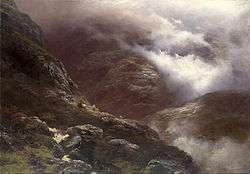 After the Massacre of Glencoe, Peter Graham | |||||
| |||||
| Belligerents | |||||
|
|
| ||||
| Commanders and leaders | |||||
|
|
| ||||
| Strength | |||||
| 920 | Unknown | ||||
| Casualties and losses | |||||
| None | 30 killed [1] | ||||
 Location within Scotland | |||||
By May 1690, the Jacobite rising of 1689 was no longer a serious military threat but unrest continued in the remote Highlands; with William also engaged in the Nine Years War, the Scottish government was under pressure to end it. In March 1690, the Jacobite chiefs agreed to swear allegiance in return for cash payments, but continually delayed; despite finally committing themselves under the June 1691 Declaration of Achallader, they still had not done so by December.
Frustrated by this, the Secretary of State for Scotland, Lord Stair, decided to make an example to provide a warning of the consequences for further delay. Why the Glencoe MacDonalds were selected is still debated; it appears to have been a combination of internal clan politics, and a reputation for lawlessness that made them an easy target.
Despite modern claims otherwise, the Massacre was not unique in Scottish history, but its brutality was shocking in the context of late 17th century Scottish society. It was a significant element in the persistence of Jacobitism in the Highlands, and remains a powerful symbol for a variety of reasons.
Background
In March 1689, James II of England and VII of Scotland landed in Ireland in an attempt to regain his throne and John Graham, Viscount Dundee, recruited a small force of Highlanders for a supporting campaign in Scotland. Despite victory at the Battle of Killiecrankie on 27 July, Dundee was killed, and organised Jacobite military resistance ended with defeats at the Battle of Dunkeld in August 1689 and Cromdale in May 1690.[2]
The continuing need to police the Highlands used resources William needed for the Nine Years' War. A peaceful Scotland was important since links between Irish and Scottish branches of the MacDonalds, as well as Scottish and Ulster Presbyterians, meant unrest in one country often spilled into the other.[3]
The Glencoe MacDonalds were one of three Lochaber clans with a reputation for lawlessness, the others being the MacGregors and the Keppoch MacDonalds. Levies from these clans served in the Independent Companies used to suppress the Conventicles in 1678–80, and took part in the devastating Atholl raid that followed Argyll's Rising in 1685.[4] They also combined against their Maclean landlords in the August 1688 Battle of Maol Ruadh, putting them in the unusual position of being considered outlaws by both the previous Jacobite administration and the new Williamite one.[5]
Oath of allegiance to William & Mary
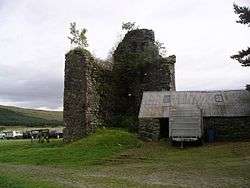
After Killiecrankie, the Scottish government held a series of meetings with the Jacobite chiefs, offering terms that varied based on events in Ireland and Scotland. In March 1690, the Secretary of State, Lord Stair, offered a total of £12,000 for swearing allegiance to William. They agreed to do so in the June 1691 Declaration of Achallader, the Earl of Breadalbane signing for the government; in July, the Battle of Aughrim ended the War in Ireland and immediate prospects of a Restoration.[6]
On 26 August, a Royal Proclamation offered a pardon to anyone taking the Oath prior to 1 January 1692, with severe reprisals for those who did not. Two days later, secret articles appeared, cancelling the agreement in the event of a Jacobite invasion and signed by all the attendees, including Breadalbane, who claimed they had been manufactured by Glengarry, the MacDonald chief.[7] Stair's letters increasingly focused on enforcement, reflecting his belief forged or not, none of the signatories intended to keep their word.[8]
In early October, the chiefs asked James for permission to take the Oath unless he could mount an invasion before the deadline, a condition they knew to be impossible.[9] His approval was sent on 12 December, and received by Glengarry on the 23rd, who did not share it until the 28th. One suggestion for the delay was an internal power struggle between Protestant elements of the MacDonald clan, like Glencoe, and the Catholic minority, led by Glengarry.[10]
As a result, MacIain of Glencoe only left for Fort William on 30 December to take the Oath from the governor, Lieutenant Colonel John Hill. Since he was not authorised to accept it, Hill sent MacIain to Inverary with a letter for the local magistrate, Sir Colin Campbell confirming his arrival before the deadline. Sir Colin administered the Oath on 6 January, after which MacIain returned home.[11] Glengarry did not swear until 4 February, with others doing so by proxy, but only MacIain was excluded from the indemnity issued by the Scottish Privy Council.[12]
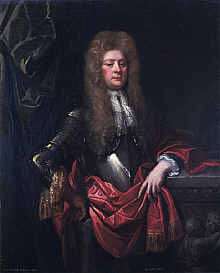
Stair's letter of 2 December to Breadalbane shows the intention of making an example was taken well before the deadline for the Oath but as a much bigger operation; ...the clan Donell must be rooted out and Lochiel. Leave the McLeans to Argyll...[13] In January, he wrote three letters in quick succession to Sir Thomas Livingstone, military commander in Scotland; on 7th, the intention was to ....destroy entirely the country of Lochaber, Locheal's lands, Kippochs, Glengarrie and Glenco...; on 9th ...their chieftains all being papists, it is well the vengeance falls there; for my part, I regret the MacDonalds had not divided and...Kippoch and Glenco are safe. The last on 11 January states; ...my lord Argile tells me Glenco hath not taken the oaths at which I rejoice....[14]
Parliament passed a Decree of Forfeiture in 1690, depriving Glengarry of his lands, but he continued to hold Invergarry Castle, whose garrison included the senior Jacobite officers Alexander Cannon and Thomas Buchan. This suggests the Episcopalian Glencoe MacDonalds only replaced the Catholic Glengarry as the target on 11 January; MacIain's son John MacDonald told the 1695 Commission the soldiers came to Glencoe from the north '...Glengarry's house being reduced.'[15]
After two years of negotiations, Stair was under pressure to ensure the deal stuck, while Argyll was competing for political influence with his kinsman Breadalbane, who also found it expedient to concur with the plan.[16] Glengarry was pardoned and his lands returned, while maintaining his reputation at the Jacobite court by being the last to swear and ensuring Cannon and Buchan received safe conduct to France in March 1692.[17] In summary, the Glencoe MacDonalds were a small clan with few friends and powerful enemies.
Massacre
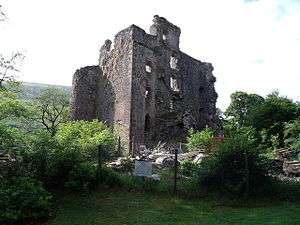
In late January 1692, two companies or approximately 120 men from the Earl of Argyll's Regiment of Foot arrived in Glencoe from Invergarry. Their commander was Robert Campbell of Glenlyon, a local landowner whose niece was married to one of MacIain's sons.[lower-alpha 1] Campbell carried orders for 'free quarter', an established alternative to paying taxes in what was a largely non-cash society.[18] The Glencoe MacDonalds themselves were similarly billeted on the Campbells when serving with the Highland levies used to police Argyll in 1678.[19]
Highland regiments were formed by first appointing Captains, each responsible for recruiting sixty men from his own estates. Muster rolls for the regiment from October 1691 show the vast majority came from Argyll, including Cowal and Kintyre, areas settled by Lowlander migrants and badly hit by the Atholl raids of 1685 and 1686.[20]
On 12 February, Hill issued orders instructing Hamilton to take 400 men and block the northern exits from Glencoe at Kinlochleven. Another 400 men from Argyll's Regiment under Major Duncanson would join Glenlyon's detachment in the south and sweep northwards up the glen, killing anyone they found, removing property and burning houses.[21]
On the evening of 12 February, Glenlyon received written orders from Duncanson carried by another Argyll officer, Captan Thomas Drummond; their tone shows doubts as to his ability or willingness to carry them out. See that this be putt in execution without feud or favour, else you may expect to be dealt with as one not true to King nor Government, nor a man fitt to carry Commissione in the Kings service. As Captain of the Argylls' Grenadier company, Drummond was senior to Glenlyon; his presence appears to have been to ensure the orders were enforced, since witnesses gave evidence he shot two people who asked Glenlyon for mercy.[22]
MacIain was killed, but his two sons escaped and the 1695 Commission was given various figures for total deaths. The often quoted figure of 38 was based on hearsay evidence from Hamilton's men, while the MacDonalds claimed 'the number they knew to be slaine were about 25.'[23] Recent estimates put total deaths resulting from the Massacre as 'around 30', while claims others died of exposure have not been substantiated.[1]

Casualties would have been higher, but, whether by accident or design, Hamilton and Duncanson arrived after the killings had finished. Duncanson was two hours late, only joining Glenlyon at the southern end at 7:00 am, after which they advanced up the glen burning houses and removing livestock. Hamilton was not in position at Kinlochleven until 11:00; his detachment included two lieutenants, Francis Farquhar and Gilbert Kennedy who often appear in anecdotes claiming they 'broke their swords rather than carry out their orders.' This differs from their testimony to the Commission and is unlikely, since they arrived hours after the killings, which were carried out at the opposite end of the glen.[24]
In his letters of 30 January to Lieutenant Colonel Hamilton and Colonel Hill, Stair expresses concern the MacDonalds would escape if warned, and emphasises the need for secrecy. This correlates with evidence from James Campbell, one of Glenlyon's company, stating they had no knowledge of the plan until the morning of 13 February.[25]
In May, fears of a French invasion meant the Argylls were posted to Brentford in England, then Flanders. The regiment remained here until the Nine Years' War ended in 1697; it was disbanded, and no action taken against those involved. Glenlyon died in Bruges in August 1696, Duncanson was killed in Spain in May 1705, Drummond survived to take part in another famous Scottish disaster of the period, the Darien Scheme.[26]
Inquiry
The killings first came to public attention when a copy of Glenlyon's orders, alleged to have been left in an Edinburgh coffee house, was smuggled to France and published in the Paris Gazette of 12 April 1692.[27] Despite criticism of the Scottish government, there was little sympathy for the MacDonalds; the military commander in Scotland, Viscount Teviot wrote that 'it's not that anyone thinks the thieving tribe did not deserve to be destroyed but that it should have been done by those quartered amongst them makes a great noise.'[28] The impetus behind an inquiry was political; as a former member of James' administration, who then became a supporter of the new regime, Stair was unpopular with both sides.[16]
.jpg)
In the debate that followed, Colonel Hill claimed most Highlanders were peaceful, and even in Lochaber, a single person may travell safley where he will witout harme. He argued lawlessness was deliberately encouraged by leaders like Glengarry, while ‘the midle sort of Gentrey and Commons....never got anything but hurt’ from it. The 1693 Highland Judicial Commission tried to encourage use of the law to resolve issues like cattle-theft, but it was undermined by the clan chiefs, as it reduced control over their tenants.[29]
The Massacre was referenced in a 1695 pamphlet by Jacobite-activist Charles Leslie, entitled Gallienus Redivivus, or Murther will out, &c. Being a true Account of the De Witting of Glencoe, Gaffney. The focus was William's alleged complicity in the 1672 death of Johan de Witt, with Glencoe and other crimes included as secondary charges.[30]
A Commission was set up to determine whether there was a case to answer under 'Slaughter under trust', a 1587 law intended to reduce endemic feuding. It applied only to murder committed in 'cold-blood', for example when articles of surrender had been agreed, or hospitality accepted, and subject to interpretation.[31] It was used to charge James MacDonald in 1597, after he locked his parents inside their house, then set fire to it, but later judged 'hot-blooded', and excluded.[4]
As both a capital offence and treason, it was an awkward weapon with which to attack Stair, as William himself signed the orders and the intent was widely known in government circles. The Commission therefore focused on whether participants exceeded their orders, not their legality; it concluded Stair and Hamilton had a case to answer but left the decision to William. [32] While Stair was dismissed as Secretary of State, he returned to government in 1700 and was made an earl by the last Stuart monarch, Queen Anne.[33]
An application by the survivors for compensation was ignored; they rebuilt their houses, and participated in the 1715 and 1745 Jacobite risings.[34] An archaeological survey in 2019 showed Glencoe was occupied until the Highland Clearances of the mid-18th century.[35]
Aftermath
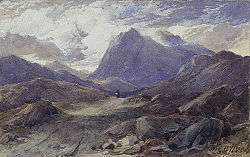
Despite claims to the contrary, Glencoe was not particularly unusual; other examples involving the MacDonalds include the 1578 Battle of the Spoiling Dyke and the Dunaverty Massacre in 1647. 'Slaughter under trust' was less common, but far from unique; it was first used in 1588 to prosecute Lachlan Maclean, who murdered his new stepfather, John MacDonald, and 18 other members of the wedding party.[36]
The Massacre became a Jacobite symbol of post-1688 oppression; in 1745, Prince Charles ordered Leslie's pamphlet and the 1695 Parliamentary minutes reprinted in the Edinburgh Caledonian Mercury.[37] It was referenced by Whig historian, Thomas Macaulay, in his 1859 History.[38] He sought to exonerate William from every charge made by Leslie, including the Massacre, which he claimed was part of a Campbell–MacDonald clan feud.[39]
Victorian Scotland developed values that were pro-Union and pro-Empire, while also being uniquely Scottish.[40] Historical divisions meant this was largely expressed through a shared cultural identity, while the study of Scottish history itself virtually disappeared from universities.[41] Glencoe became part of a focus on 'the emotional trappings of the Scottish past...bonnie Scotland of the bens and glens and misty shieling, the Jacobites, Mary, Queen of Scots, tartan mania and the raising of historical statuary.'[42]
After the study of Scottish history re-emerged in the 1950s, Leslie's perspectives continued to shape views of William's reign as particularly disastrous for Scotland. The massacre was only one in a series of incidents deemed as such, including the Darien scheme, the famine of the late 1690s, and the Union of 1707.[43] It is still commemorated in an annual ceremony by the Clan Donald Society; initiated in 1930, this is held at the Upper Carnoch memorial, a tapering Celtic cross installed in 1883 at the eastern end of Glencoe village.[44]
Its continuing emotional power was demonstrated in 1998, when a plaque was installed at a granite boulder south of Carnach.[45] Originally known as the 'Soldier's Stone', [46] in the late 19th century, it was renamed Clach Eanruig, or 'Henry's Stone'; it is currently named the Henderson Stone, after the family reputed to be pipers to MacIain.[47]
In popular culture
Glencoe was a popular topic with 19th century poets, the best-known work being Sir Walter Scott's "Massacre of Glencoe".[48] It was used as a subject by Thomas Campbell and George Gilfillan, whose main claim to modern literary fame is his sponsorship of William McGonagall, allegedly the worst poet in British history. Other poetic references include Letitia Elizabeth Landon's "Glencoe" (1823), T. S. Eliot's "Rannoch, by Glencoe" and "Two Poems from Glencoe" by Douglas Stewart.[49]
Examples in literature include "The Masks of Purpose" by Eric Linklater, and the novels Fire Bringer by David Clement-Davies, Corrag (known as Witch Light in paperback) by Susan Fletcher and Lady of the Glen by Jennifer Roberson. William Croft Dickinson references Glencoe in his 1963 short story "The Return of the Native". A Song of Ice and Fire author, George R. R. Martin, cites the Glencoe Massacre as one of two historical influences on the infamous "Red Wedding" in his 2000 book A Storm of Swords.[50]
Recent archaeological work
In 2018, a team of archaeologists organised by the National Trust for Scotland began surveying several areas related to the massacre, with plans to produce detailed studies of their findings.[51] Work in the summer of 2019 focused on the settlement of Achtriachtan, at the extreme end of the glen; home to an estimated 50 people, excavations show it was rebuilt after 1692 and still occupied in the mid-18th century. No artifacts relating to the Massacre have been found as yet.[35]
Notes
- As per John Prebble's account 'Glencoe; the Story of the Massacre,' this was John MacDonald, who served in the Jacobite force under Thomas Buchan scattered at Cromdale in May 1690.
- You are hereby ordered to fall upon the rebells, the McDonalds of Glenco, and put all to the sword under seventy. you are to have a speciall care that the old Fox and his sones doe upon no account escape your hands, you are to secure all the avenues that no man escape. This you are to putt in execution att fyve of the clock precisely; and by that time, or very shortly after it, I’ll strive to be att you with a stronger party: if I doe not come to you att fyve, you are not to tarry for me, but to fall on. This is by the Kings speciall command, for the good & safety of the Country, that these miscreants be cutt off root and branch. See that this be putt in execution without feud or favour, else you may expect to be dealt with as one not true to King nor Government, nor a man fitt to carry Commissione in the Kings service. Expecting you will not faill in the full-filling hereof, as you love your selfe, I subscribe these with my hand att Balicholis Feb: 12, 1692.
References
- Campsie.
- Lenman 1995, pp. 37-38.
- Lang 1912, pp. 284–286.
- Levine 1999, p. 128.
- Levine 1999, p. 137.
- Harris 2007, p. 439.
- Levine 1999, p. 139.
- Gordon 1845, pp. ?.
- Szechi 1994, p. 45.
- Szechi 1994, p. 30.
- Buchan 1933, p. 59.
- Levine 1999, p. 140.
- Goring 2014, pp. 94–96.
- Goring 2014, pp. 97–100.
- Cobbett 1814, p. 904.
- Levine 1999, p. 141.
- MacConechy 1843, p. 77.
- Kennedy 2014, p. 141.
- Lenman 1991, pp. 238–239.
- Argyll Transcripts 1891, pp. 12–24.
- Somers 1843, p. 538.
- Somers 1843, p. 536.
- Cobbett 1814, pp. 902–903.
- Howell 2017, p. 903.
- Somers 1843, p. 537.
- Preeble 1968, p. 103.
- Levine 1999, p. 143.
- Prebble 1973, p. 198.
- Kennedy 2017, pp. 32–60.
- Frank 1983, pp. 103-115.
- Harris 2015, pp. 53–54.
- Somers 1843, p. 545.
- Hopkins 1998, p. 395.
- Prebble 1973, p. 214.
- MacDonald.
- Levine 1999, p. 129.
- Hopkins 1998, p. 1.
- Macaulay 1859, p. 277.
- Firth 1918, p. 287.
- Morris 1992, pp. 37–39.
- Kidd 1997, p. 100.
- Ash 1980, p. 10.
- Kennedy 2017, pp. 32–33.
- "Site Record for Glencoe, Massacre Of Glencoe Memorial; Macdonald's Monument; Glencoe Massacre". Royal Commission on the Ancient and Historical Monuments of Scotland. Retrieved 4 November 2013. Cite journal requires
|journal=(help). Memorial is at grid reference NN1050958793. - Pagan.
- Dorson 1971, p. 156.
- Donaldson 1876, pp. 298, 301.
- Scott.
- Stewart Douglas. Two Poems from Glencoe Archived 15 July 2015 at the Wayback Machine, at Australian Poetry Library. Accessed 5 October 2015
- Hibberd, James (2 June 2013). "Game of Thrones author George R R Martin why he wrote the red wedding". Entertainment Weekly. Retrieved 12 March 2019.
- Treviño.
Sources
- Argyll Transcripts, ICA (1891). "An Account of the depredations committed on the Clan Campbell and their followers during the years 1685 and 1686". Historical Manuscripts Commission.
- Ash, Marinell (1980). The Strange Death of Scottish History. The Scottish Historical Review. 76. Ramsay Head Press. ISBN 0902859579. JSTOR 25530740.
- Buchan, John (1933). Massacre of Glencoe (1990 ed.). Lang Syne Publishers Ltd. ISBN 1852171642.CS1 maint: ref=harv (link)
- Campsie, Alison (12 February 2018). "The Scotsman". Archaeologists trace lost settlements of Glencoe destroyed after 1692 massacre. Retrieved 3 July 2018.
- Cobbett, William (1814). Cobbett's Complete Collection Of State Trials And Proceedings For High Treason And Other Crimes And Misdemeanors. Nabu Press. ISBN 1175882445.
- Donaldson, M. (1876). Wanderings in the Western Highlands and Islands : Recounting Highland & Clan History, Traditions, Ecclesiology, Archaeology, Romance, Literature, Humour, Folk-Lore, Etc (1923 ed.). Paisley.CS1 maint: ref=harv (link)
- Dorson, Richard (1971). "Sources for the Traditional History of the Scottish Highlands and Western Islands". Journal of the Folklore Institute. 8 (2). JSTOR 3814103.CS1 maint: ref=harv (link)
- Firth, CH (1918). "Macaulay's Treatment of Scottish History". The Scottish Historical Review. 15 (60). JSTOR 25519104.CS1 maint: ref=harv (link)
- Frank, William (1983). Charles Leslie and Theological Politics in Post-Revolutionary England. University of McMaster PHD.CS1 maint: ref=harv (link)
- Gordon, John (1845). Papers Illustrative of the Political Condition of the Highlands of Scotland, 1689–1706 (2015 ed.). Sagwan Press. ISBN 978-1340252717.CS1 maint: ref=harv (link)
- Goring, Rosemary (2014). Scotland: The Autobiography: 2,000 Years of Scottish History by Those Who Saw it Happen. Penguin. ISBN 978-0241969168.CS1 maint: ref=harv (link)
- Harris, Tim (2015). Rebellion: Britain's First Stuart Kings, 1567–1642. OUP Oxford. ISBN 978-0198743118.CS1 maint: ref=harv (link)
- Harris, Tim (2007). Revolution; the Great Crisis of the British Monarchy 1685-1720. Penguin. ISBN 0141016523.CS1 maint: ref=harv (link)
- Hopkins, Paul (1998). Glencoe and the end of the Highland Wars. John Donald Publishers Ltd. ISBN 0859764907.CS1 maint: ref=harv (link)
- Howell, Thomas Bayly (2017). A Complete Collection of State Trials and Proceedings for High Treason. Forgotten Books. ISBN 978-1333019327.CS1 maint: ref=harv (link)
- Kennedy, Allan (April 2017). "Managing the Early Modern Periphery: Highland Policy and the Highland Judicial Commission, c. 1692–c. 1705". The Scottish Historical Review. 96: 32–60. doi:10.3366/shr.2017.0313.CS1 maint: ref=harv (link)
- Kennedy, Allan (2014). Governing Gaeldom: The Scottish Highlands and the Restoration State 1660–1688. Brill. ISBN 978-9004248373.CS1 maint: ref=harv (link)
- Kidd, Colin (April 1997). "The Strange Death of Scottish History Revisited; Constructions of the Past in Scotland c1790-1914". Scottish Historical Review. lxxvi (100). JSTOR 25530740.;
- Lang, Andrew (1912). The History Of Scotland: Volume 3: From the early 17th century to the death of Dundee (2016 ed.). Jazzybee Verlag. ISBN 978-3849685645.CS1 maint: ref=harv (link)
- Lenman, Bruce; The Jacobite Risings in Britain 1689–1746; (1980;
- Lenman Bruce, Mackie JL (1991). A History of Scotland. Penguin. ISBN 0140136495.
- Leslie, Charles; Gallienus Redivivus, or Murther will out, &c. Being a true Account of the De Witting of Glencoe, (Gaffney, 1695);
- Levine, Mark (editor) (1999). The Massacre in History (War and Genocide). Bergahn Books. ISBN 1571819355.CS1 maint: extra text: authors list (link) CS1 maint: ref=harv (link)
- Macaulay, Thomas Babington. The History of England from the Accession of James II. IV (1859 ed.).CS1 maint: ref=harv (link)
- MacConechy, James (1843). Papers Illustrative of the Political Condition of the Highlands of Scotland (2012 ed.). Nabu Press. ISBN 1145174388.;
- MacDonald, Kenneth (11 May 2019). "The dig uncovering Glencoe's dark secrets". BBC. Retrieved 13 October 2019.
- Morris, R. J. (1992). "Victorian Values in Scotland & England". In Smout, T. C. (ed.). Victorian Values. Proceedings of the British Academy. 78. ISBN 978-0197261194.CS1 maint: ref=harv (link)
- Pagan, Sue (17 September 1998). "Henderson Stone dedicated at Glencoe". The Oban Times. Retrieved 3 July 2018.
- Prebble, John (1973). Glencoe: The Story of the Massacre. Penguin. ISBN 0140028978.
- Prebble, John (1968). Darien: the Scottish Dream of Empire (2002 ed.). Pimlico. ISBN 978-0712668538.
- Scott, Sir Walter. "On the Massacre of Glencoe". Bartleby.com. Retrieved 28 January 2018.
- Somers, John (2014). A Collection Of Scarce And Valuable Tracts, On The Most Interesting And Entertaining Subjects: Reign Of King James II. Reign Of King William III. Nabu Press. ISBN 978-1293842225.CS1 maint: ref=harv (link)
- Szechi, Daniel (1994). The Jacobites: Britain and Europe, 1688–1788. Manchester University Press. ISBN 0719037743.CS1 maint: ref=harv (link)
- Treviño, Julissa (26 March 2018). "Archaeologists Trace 'Lost Settlements' of 1692 Glencoe Massacre". smithsonianmag.com. Smithsonian Institution. Retrieved 27 March 2018.
External links
- Glencoe Massacre on In Our Time at the BBC
- Parliamentary Register, with full details of the Commission of Inquiry's Address to William III, 10 July 1695;
- History – Massacre of Glencoe 1692—BBC: brief account of the massacre
- Macaulay's History of England, chapter XVIII Includes a well written and moderately detailed account of the massacre in its political context, with footnotes to original source documents. However, it should be read with caution as Macaulay had a very specific perspective.
- Glen Coe Massacre Detailed account of the events leading up to the massacre and the massacre itself.
- Glencoe Very detailed and balanced account of the plot and massacre.
- The Vale of Glencoe Radio episode from the series Quiet, Please. Poor sound quality, but the radio script may be found below.
- The Vale of Glencoe Radio Script OTR Plot Spot—plot summaries, scripts and reviews of Old Time Radio shows, including "The Vale of Glencoe", above.

.svg.png)